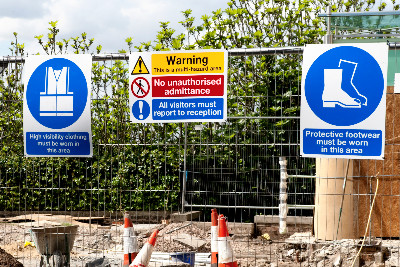We may not often think about it, but signs play an important part in keeping us safe during our day-to-day lives. They tell us when to stop at an intersection, if there is construction work ahead or when it’s safe to cross the street.
our day-to-day lives. They tell us when to stop at an intersection, if there is construction work ahead or when it’s safe to cross the street.
The same goes for the workplace. Signs play a huge role in telling workers what hazards are present and how they avoid those dangers. To be most effective, these signs must be understandable so that workers will know what to do to stay safe in different work environments.
“Although safety signs and warnings are low on the hierarchy of controls, they are an important part of communicating with employees about the hazards in the workplace,” says Diana Stegall, executive vice president of Rivendell Safety Consulting. “Signs that are well-positioned and take into consideration the hazard ‘audience’ can be very effective in communicating a hazard and serving as a reminder when no one else is around.”
These three steps can help you ensure that signs in your facility help employees understand the risks present in different environments.
Speak the Language of Safety
Signage needs to easily and effectively communicate its message to everyone on the job site. Without a clear understanding of the hazards present in different working environments, workers don’t have the knowledge necessary to operate safely.
“The purpose of a safety sign is to give people the information they need to act safely, and to provide that information when and where it’s needed,” says Brian McFadden, compliance specialist at Graphic Products. “If you keep that goal in mind, the regulations and standards for signage become how-to guides and help you make improvements to your workplace communication in the name of safety.”
With regard to regulations, the ANSI/NEMA Z535 series of standards establishes requirements for the design, application and use of safety signage. This includes color coding, sign size, text size and viewing distance. For example, the standard states that yellow be incorporated in signage where minor or moderate hazards are present, orange for more serious hazards and red for the most severe hazards.
Using these as a foundation for safety signage, employees begin to understand and recognize the types of hazards associated with different types of machinery and environments.
Along with the Z535 requirements, Stegall stresses that employers, safety professionals and others need to consider the “audience” for each sign, which means thinking about the demographics of their workforce.
It’s important to know that literacy rates vary from worker to worker and that not all workers may speak the same language. Therefore, signs should be easily understood in whatever language(s) are spoken in the workplace.
“When multiple languages are used in a workplace, signs featuring all those languages are a common solution,” says McFadden. “Many signs are available in bilingual formats and custom signs can be created with any selection of languages.”
Location, Location, Location
A sign is only truly effective if it is appropriately placed on a worksite. This includes both the location of signage on machinery as well as ensuring that signage is placed outside of a hazardous work area well enough in advance for workers to be aware and take proper precautions.
“Signage should be positioned close enough to a hazard so that it is relevant, but not so close that employees enter a potentially dangerous area before seeing the sign,” says Stegall. “Ask yourself, ‘Is the sign positioned close enough to the hazard that it is relevant, but not so close that the employee is entering a potentially dangerous area before they will see the sign?’”
Avoid Mixed Messages
While signage is an important element of workplace safety culture, Stegall emphasizes that there can be too much signage and safety professionals need to be mindful of that in their work environments.
“You don’t want to have so many signs that the warnings blend together,” she says. “Having one safety sign after another or signs that contradict each other since they warn of different hazards can create confusion among your workers.”
McFadden encourages employers to focus on consistency across the job site. This means if similar signage is needed in multiple places, the messaging of those signs should be conveyed in similar ways. This help workers quickly understand the context of any given sign.
“It’s easy to go overboard with signage,” says McFadden. “Before posting any new sign, think about its purpose. What information, specifically, needs to be provided? If you post a new sign in a given location, will its message be relevant, timely and actionable when a worker reads it?”
Above all, McFadden emphasizes the importance of viewing safety signage as just one component of a safety and health management system and how effective communication fits in with your overall workplace safety culture.
“Signage is an important part of the overall safety puzzle, but it’s just one piece. No sign, on its own can make your workplace safer in practice,” he says. “Building a safe workplace culture requires commitment and participation at every level of the organization.”
Understanding Risk Management and Assessment
We have the resources and expert guidance you need to improve how you assess risks to prevent hazards, protect workers and safeguard equipment.
Learn more